[Retracted] The Mechanism of Safety Culture Construction in Chinese Universities Based on POI Data and Gravity Model
Abstract
Safety culture includes concept culture, system culture, behavior culture, and material culture. With the development of social economy, the importance of safety culture has been recognized by the whole society. Campus security is not only related to the common interests of the campus teachers and students but also related to the fundamental interests of each individual in the campus. In order to build a “harmonious society,” building a “harmonious campus” is an important work. Strengthening the construction of safety culture in colleges and universities is not only the objective need of building a harmonious society, promoting the reform and development of colleges and universities, and running a university with the satisfaction of the people but also the urgent requirement of cultivating high-quality professionals with safety responsibility consciousness and safety behavior ability. Starting from the history of safety culture construction, this paper reviews and summarizes the course of safety culture construction in colleges and universities, analyzes the present situation of safety culture construction in colleges and universities, and takes the safety construction theory as the guide. This paper introduces an automatic extraction technology of Internet map POI data. The organization form of Html webpage content, the automatic analysis, and the extraction of POI are realized by programming. The experimental results show that the address standardization method proposed in this paper has high accuracy of address standardization, and the weighted multiattribute similarity POI matching method can also effectively update the increment of POI data.
1. Introduction
After the reform and opening up, China’s national ideological work has entered a new period and a new stage with the development of the times, which has brought opportunities for China to comprehensively deepen reform and development [1]. Safety culture refers to the sum of all safe material wealth and spiritual wealth created to ensure the physical and mental health and safety of human beings in the process of production and life practice. It is a complex of safe values, ideals, beliefs, ethos, highest goals, and codes of conduct [2]. It covers four levels: safety culture at the material level, safety culture at the institutional level, safety culture at the behavioral level, and safety culture at the spiritual level [3]. China’s higher education has stood at a brand-new historical starting point, and the launch of the “double first-class” construction has further promoted the higher education from the scale expansion type extension development to the quality-oriented connotation development. In such a process of transformation and development, colleges and universities can only adapt to this historical opportunity of development through reform and change [4]. The reform of colleges and universities is changing from single reform to comprehensive reform and from incremental reform to stock reform. The reform has entered the “deep water area,” and the rest are all “hard bones.” The reform means the balance of breaking the old, the adjustment of interests, and the intensification of deep-seated contradictions. The sustainable development of colleges and universities is facing various internal resistance and heavy pressure [5].
For social progress, the security work needs the collective participation of the masses, which is no longer limited to simple management, and the scope of work expands to the cultivation of campus security culture. Therefore, efforts should be made to build a development space suitable for school security management, strengthen the construction of campus security culture, and continuously promote the upgrading of campus security management, which is a key point and direction for colleges and universities to carry out security work in the future [6]. This is a brand-new subject under the new situation and new requirements, and it is also an inevitable need for safety work to lay a foundation, grasp the fundamentals, and take care of the long term. The connotation construction of colleges and universities mainly lies in the construction of campus culture [7]. Campus culture is a concentrated expression of the thinking mode, behavior habits, and working attitude of all teachers and students, and it is an important symbol of a school’s connotation, level, and taste. We should vigorously strengthen the construction of distinctive campus culture and strive to cultivate a school spirit with fine traditions and profound cultural heritage through various forms such as the guidance of various systems, the promotion of school motto, the display of achievements in campus construction, the development of various cultural activities, and the construction of cultural attractions [8]. The exploration and practice of campus safety culture in colleges and universities in China have been less than ten years, but many colleges and universities have made some useful attempts. The details are as follows: (1) management system: the main body of the security management system of colleges and universities in China is the security department or security department of the school. They exist as the functional department of the unit and the representative organization sent by the public security organ and can exercise the power entrusted by the public security department. The security institutions of colleges and universities no longer have the power of law enforcement and are no longer the grass roots organizations of public security organs but only exist as a functional department of colleges and universities. (2) Preventive measures: at present, it mainly relies on two types, namely, civil air defense and physical defense. (3) Management team: the security management team in colleges and universities in China is mainly composed of security department or section cadres, security guards, student autonomous organizations, etc. The quality and ability in policy level, political theory, and the ability to deal with emergencies are not high, which makes it difficult to be competent for the security management and implementation of colleges and universities. Therefore, under the new situation of the rapid development of colleges and universities, how to deal with all kinds of unsafe factors in time, and how to construct the safety culture of colleges and universities more effectively from both the subject and the object, has become an important task in front of the safety construction of colleges and universities [9, 10].
Today in the 21st century, all aspects of human life are inseparable from the Internet. As the place with the most human activities, the Internet covers a wealth of information, which is rapidly updated, including a large number of information related to spatial location. Making full use of Internet information to mine effective POI information will be a supplement to traditional POI data updating technology and also an important content and development direction of information services. Therefore, how to extract new POI data from amount update the existing POI data is an important and urgent problem. According to the characteristics of POI data obtained from the Internet, combining the name, address, latitude, and longitude and comparing the previous POI data provide an effective method for incremental updating of network POI data.
Its innovations are as follows: (1) it enriches the research on ideological security construction in colleges and universities and further comprehensively discusses the ideological security construction in colleges and universities. (2) Put forward my own opinions on the consideration of ideological security. The consideration of ideological security is a major issue that this paper cannot get around.
2. Related Work
Ideological research is both ancient and constantly updated with the change of times. In recent years, scholars have continuously expanded the research on ideological issues to various fields and made detailed and systematic analysis. Especially in China, where profound changes have taken place both at home and abroad, marketization, globalization, and networking urge us to have a deeper understanding of ideology and its security issues.
Maffei discussed the strategic choice of college ideology in the study of ideological work in colleges and universities, emphasized the important role of party building in colleges and universities in leading the mainstream ideology, analyzed the function of the ideological and political education mechanism, and discussed in detail such issues as campus culture, social science research, nationalized school running, youth public welfare service, and national defense student education [11]. Li pointed out that raising safety work to the level of safety culture shows that the Chinese government has begun to realize the importance of safety culture construction [12]. Wu and Lei pointed out: “our college is a unit that trains talents and carries out scientific research. It is a place where professional and technical personnel and modern scientific research equipment are concentrated. Therefore, the fire safety work of the college should be placed on the agenda and attached great importance to, so that it can truly realize institutionalization, standardization, and scientization and keep pace with the development of the whole educational cause of our college [13]. Boussat et al. proposed a matching model based on probability theory for the determination of the same name features of planar features, combined with multiple matching indicators, to avoid the selection of the exact closed value of the matching indicators [14]. Lnka et al. proposed that the socialist core value system should be based on history and reality and serve practice and reality to guide the development of education [15]. Wang and Zhang described the structure of the socialist core value system and specially discussed the soul, theme, essence, and foundation of the socialist core value system and elaborated the construction path of the socialist core value system [16]. Kaminski et al., in the study of ideological security and political values of college students, focused on the ideological work to conduct a profound and thorough discussion on the formation of political values of college students and scientifically analyzed the current situation, formation rules and acceptance mechanism, and construction of educational content and educational methods of political values of college students [17]. Lizarazo pointed out that “national security is the security of the three components of a country, that is, the national body security, the environmental security and the ideological security. As the security of these three aspects, it is the security of development [18].” Jiang et al. believe that “life is not determined by consciousness, but by life.” Therefore, at the same time of macroscopic discovery of major problems, it is more necessary to start with the grass roots practice of colleges and universities and find and analyze problems from the daily life of teachers and students [19]. Cheng et al. and Zhang et al. put forward four principles for the construction of ideological security in colleges and universities, that is, to strengthen the party’s leadership over the construction of ideological security in colleges and universities, adhere to the principle of “people-oriented” in the construction of ideological security in colleges and universities, adhere to the principle of “advancing with the times” in the construction of ideological security in colleges and universities, and adhere to the principle of inclusiveness in the construction of ideological security in colleges and universities: four platforms, namely, classroom education, campus culture, community activities, and campus media, and three operating mechanisms, namely, prevention mechanism, emergency mechanism, and guarantee mechanism [20–24].
3. Methodology
3.1. Summary of the Construction Mechanism of Safety Culture in Colleges and Universities
With the progress of human society, human beings have evolved from farming civilization to industrial civilization. At a specific stage, people keep learning and mastering knowledge and skills, inventing, and creating, forming an established habit and daily behavior norm. This sum of material wealth and spiritual wealth, which is accepted by all members and recognized by the society and continuously inherited, innovated, and developed, is called culture. Safety is a state where individuals and the environment are in a state of no danger, no harm, and no loss, and at the same time, the possibility of danger in the future is avoided. The safety culture refers to the safety system, safety behavior, safety concept, and the construction of safety materials, which are formed in order to achieve a safe state. It is mainly expressed in the form of safety concept, safety awareness, and safety behavior. At present, the safety culture has basically formed a complete theoretical system. The construction of safety culture in colleges and universities is based on the internalization of concept culture, the solidification of system culture, the assimilation of behavior culture and the externalization of material culture, and the training of teachers and students with safety awareness and safety values, so as to jointly promote the construction of a safe and civilized campus.
Safety culture has broad and narrow meanings, but safety culture mainly trains people to meet the needs of modern society and have safe feelings, values, and behaviors through the way of “cultural enlightenment.” The purpose of establishing safety culture is to ensure the safety and health of people’s life and work under the existing technical management conditions. These cannot be separated from people’s cherishing and paying attention to their own physical and mental safety, so that their words and deeds can meet the requirements of the safety code of conduct. Through the education and edification of safety culture in production and life practice, people can constantly improve their own safety culture health quality, prevent accidents, and ensure the quality of daily life. This is the essence of the so-called safety culture. Based on the above understanding, there are several basic requirements for maintaining the safety and stability of college students. (1) On the basis of fairness, it is the key to ensure the safety and stability of college students to construct a system and mechanism to adapt and coordinate various complex interests. (2) On the premise of expanding democratic participation, it is an effective way to ensure the safety and stability of college students by improving and promoting the democratic management of colleges and universities and administering schools according to law. (3) Upholding and improving the party’s leadership as the core is the political guarantee to realize the safety and stability of college students. (4) People-oriented, strengthening and improving ideological and political education is an important project to ensure the safety and stability of college students. College safety culture consists of concept culture, system culture, behavior culture, and material culture. Safety concept culture is the core, safety system culture is the guarantee, safety behavior culture is the representation, and safety material culture is the cornerstone, as shown in Figure 1.
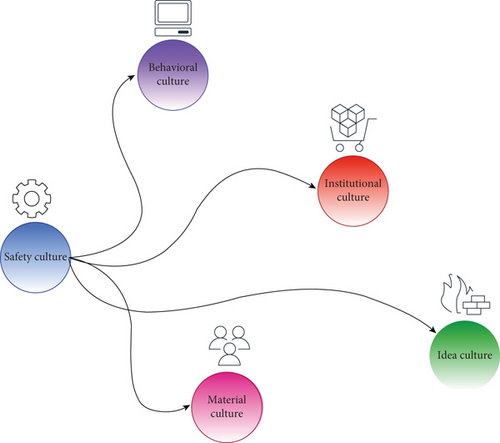
In the long-term development of colleges and universities, a set of thought, behavior, and value norms accepted by all teachers and students and consciously observed by them will be formed. The safety concept culture is a set of code of conduct, safety values, and safety style that college teachers and students must abide by. Safety concept culture is the core of safety culture and the internalization of safety culture; plays a guiding role in the construction of material, system, and behavior culture; and is the spiritual wealth of safety culture construction. There are three elements in the construction of safety culture in colleges and universities, place, time, and people, among which people play a decisive role. The makers of the safety management plan are university leaders, the executors of safety management are security personnel, and the target objects of safety management are teachers, students, and employees. The participation and initiative of all university staff provide conditions for the creation of safety culture. In the process of construction, meeting the needs of teachers and students is the driving force to promote the continuous improvement of safety culture construction. Therefore, safety culture should be guided by the results of staged safety construction, aiming at meeting the needs of teachers and students, and the safety culture construction scheme should be continuously upgraded and improved. Under this general goal, the goal of building concept culture lies in unified values, the goal of building system culture lies in unified system norms, the goal of building behavior culture lies in unified standard behaviors, and the goal of building material culture lies in a safe material environment.
3.2. Analysis of University Safety Culture Construction Structure Based on POI Data
In the long-term running of colleges and universities, it is necessary to invest more financial resources and energy in the construction of campus safety culture, which is a long-term task. Similarly, the theoretical research foundation of safety culture is equally profound. The system theory holds that the common basic characteristics of all systems include openness, complexity, self-organization, relevance, integrity, dynamic balance, hierarchical structure, and timing. The whole concept of system is its core idea. He believes that any system is an organic whole, and the overall function of the system is the nature of each element in an isolated state, with integrity. Using the basic thought and method of system theory to study the campus safety culture to treat the objects studied by the university safety culture as a system; study the interrelationship and change laws among the system, elements, and environment; analyze the structure and function of the system; and look at the problems from a systematic perspective and then using these characteristics and laws to control and manage or transform or even create a new university safety system make the existence and development of this security system more in line with people’s purposes and needs.
In formula (1), a ∈ A, b ∈ B, confidence({a, b}) represents the confidence of the fusion set {a, b}, wherein the geographic entity a and the geographic entity b are the closest neighbors to each other, a2 is the next nearest neighbor of the geographic entity b in A, and b2 is the next nearest neighbor of the geographic entity a in B. When the confidence given threshold, it is the fusion set. The mutual nearest neighbor algorithm is shown in Figure 2.

Internet map service covers a lot of POI data, such as Baidu map and Gaode map. Lots of POI thematic data are stored in various vertical websites, such as hospitals, scenic spots, shopping, and other information. Crawling POI data from such vertical websites mainly depends on focused crawler engines. However, a large part of Internet POI data exists in various WebGIS applications and network map services. These applications are based on Ajax asynchronous data transmission technology to complete the query and interaction of POI data. In view of this kind of web service crawling, it is necessary to use dark web crawling technology. In order to crawl vertical websites and deep POI data, it is necessary to design a web crawler compatible with the above two data sources. The crawler is composed of three basic modules: task scheduling, data downloading, and data analysis. In general, the web spatial data crawler is circular, which enables the crawler to run automatically and persistently. The basic architecture is shown in Figure 3.
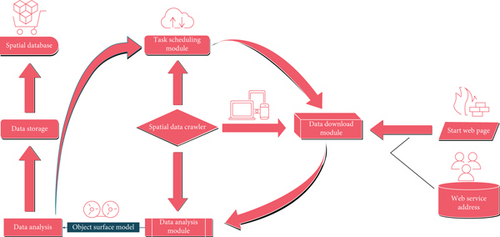
The important module of POI crawling is the task scheduling module, because it not only provides the functions of URL address filtering and deduplication but also has the function of assigning tasks to each thread in a multithreaded environment. For vertical web pages, the task scheduling module compares the URL addresses existing in the web pages with the existing address list by analyzing them and deletes the crawled URL of the web pages. For the website service, the corresponding request is generated by giving certain service request parameters according to the rules, and then, the request queue is dynamically adjusted according to the corresponding rules, and finally, the newly added request is transmitted to the data download module.
3.3. Basic Method of Multisource Spatial Data Fusion
In the above formula, ΔX0, ΔY0, ΔZ0 is the coordinate translation parameter; εX, εY, εZ is a coordinate rotation parameter and a transformation scale parameter.
The calculation model represented by formula (3) reflects the transformation process of two spatial rectangular coordinate systems, and the solution of this process needs to calculate the parameter ΔX0, ΔY0, ΔZ0, εX, εY, εZ, m. In this case, the number of common points should be no less than three. If there are more than three common points, the values of the above seven parameters can be calculated according to the least square fitting method.
The greater the calculation result, the greater the similarity between the two strings. The maximum value of 1 indicates that the name fields of the two POI objects to be compared are identical, and the minimum value of 0 indicates that the name fields of the two POI objects to be compared are completely different.
The higher the Jaccard value, the greater the similarity of the names of the two POI objects, and the greater the possibility that they are the same entity.
where S1, S2 represents the name strings of the two POI objects to be matched, m refers to the same number of characters, and t is the number of exchanges.
It is also a user-defined variable parameter.
In this paper, different string matching algorithms are used to match the name fields, and the similarity of the two name fields is counted. Then, according to the set threshold value, the accuracy, recall, and F value of the experimental results are counted. Levenshtein editing distance algorithm with high accuracy, recall, and F value is selected for the research, as shown in Table 1.
| Name similarity algorithm | Accuracy | Recall | F value |
|---|---|---|---|
| Levenshtein edit distance algorithm | 0.95 | 0.95 | 0.935 |
| Jaccard similarity algorithm | 0.91 | 0.84 | 0.812 |
| Jaro distance algorithm | 0.86 | 0.87 | 0.847 |
4. Result Analysis and Discussion
Campus safety culture belongs to safety consciousness or safety ideology system and is the sum of safety material wealth and safety spiritual wealth with university characteristics. The change of times and concepts requires the constant innovation of the concept of the construction of safety culture on campus. Civil air defense, physical defense, and technical defense are the three major elements of establishing a security system. In security work, the three must be effectively combined and unified to build an all-weather and all-round security firewall. Due to the vigorous development of economy and modern technology, most universities have reached a high level in the construction of technical defense and physical defense and played their due role. Practice has proved that no matter how high the level of technical and physical defense is, ignoring the role of civil air defense will inevitably lead to accidents. Therefore, in the process of establishing the security system, we must establish dialectical thinking, adhere to the unity of the two-point theory and the key theory, highlight the main position of people, give priority to civil defense, and adhere to the combination of civil defense, physical defense, and technical defense. Based on the above method, the calculated errors after dividing the grid into eight degrees, four degrees, two degrees, one degree, thirty minutes, and fifteen minutes are shown in Table 2.
| Accuracy evaluation | Longitudinal median error | Error in dimension | Maximum longitudinal error | Longitude minimum error | Maximum latitude error | Minimum latitude error |
|---|---|---|---|---|---|---|
| Octave | 1.46743 | 0.04764 | 42.14647 | 0.19846 | 0.34426 | 0.0000032 |
| Sidu | 0.81284 | 0.04643 | 1.465474 | 0.00476 | 0.21478 | 0.0000430 |
| Bis | 0.14379 | 0.00474 | 0.144437 | 0.04147 | 0.00003 | 0.0000001 |
| Once | 0.01443 | 0.00072 | 0.279417 | 0.00001 | 0.00001 | 0.0000001 |
| Thirty minutes | 0.00447 | 0.00001 | 0.004474 | 0.00001 | 0.00446 | 0.0000001 |
The error trend is shown in Figure 4.
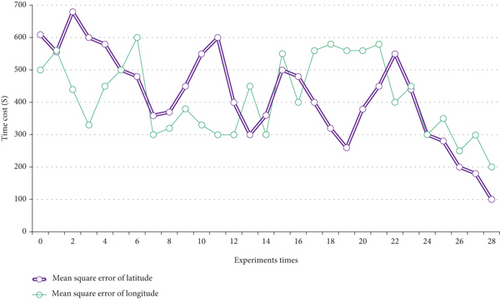
From the above calculation results, it can be seen that the degree of grid division is proportional to the error, and the finer the degree of grid division, the smaller the error. In the case of dividing the geographic grid by fifteen points, the correction accuracy is within 1 m, which better realizes the position correction of multisource geographic point groups. The following two figures are schematic diagrams of some POI positions before and after correction. It can be seen that before the position correction, the two sets of data sources have obvious position deviation, and after the correction, the second set of data source “matches” with the first one, finally realizing the geometric position fusion of the two sets of POI data, as shown in Figures 5 and 6.
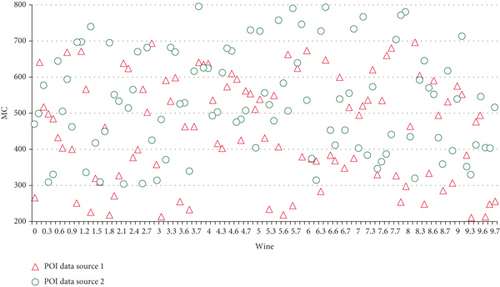
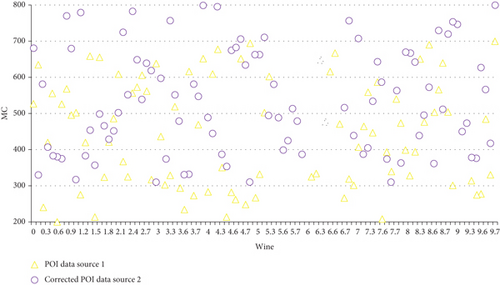
The evaluation of the effectiveness of the construction of safety culture in university is divided into two parts. One is the self-evaluation carried out in university. The main purpose of the self-evaluation is to affirm the achievements and find out the shortcomings through self-examination and self-evaluation. It is an effective measure for the school to continuously improve itself and promote the construction of safety culture. The second is the evaluation of the safety culture construction of university organized by the higher authorities or the third party. The main purpose of the evaluation is to measure the advantages and disadvantages of the safety culture construction among university through the general evaluation and then give guiding suggestions for further strengthening the safety culture construction of university. In order to improve the project management level, we must constantly strengthen the scientific management concept, actively integrate the campus culture into the overall management, and promote the scientific, standardized, and institutionalized project management. On the basis of further exploration of project management, the management system of each department shall be refined, and the responsibilities, work systems, and assessment and evaluation standards of each post of the project shall be clarified, so that the project management system can be implemented in place horizontally and vertically, and the standardization construction level of the project can be continuously improved. It is necessary to have daily material equipment of preventive and protective nature, and the personnel participating in the security work should also have the ability to deal with crisis quickly. It is necessary not only to have traditional and general safety culture knowledge but also to have professional personnel and high-tech configuration required for campus safety culture construction to meet the challenges of the information age. The systematic principle can effectively mobilize the enthusiasm of various departments for cooperation, increase their coordination, improve work efficiency, and ensure the implementation of various safety protection work. In terms of ideological understanding, management personnel should highly highlight the construction concept of “full access, full participation, full management, full implementation and full control”; highlight the “safety awareness” of teachers and students; and run the training of safety quality through all links and levels of teaching management. Only with the joint efforts of all teachers, students, and employees of university and the mutual coordination of all units can the school safety culture be gradually formed in the long-term teaching and education practice, developed with the direct participation and careful training of the majority of teachers and students, and play a practical role in protecting the physical and mental safety of teachers and students and the property safety of university.
By using the above method, the similarity of the three attribute fields of POI in the experimental data is calculated, and different thresholds are set to distinguish the matched and unmatched POI, and the accuracy chart shown in Figure 7 can be obtained.
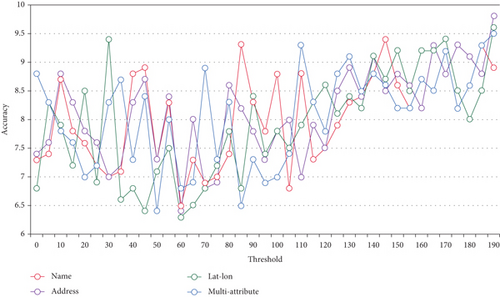
As can be seen from the above figure, the latitude and longitude of POI can identify mismatched POI matches, and the accuracy is much better than that of names, but the overall accuracy is still lower than that of address fields. The evaluation of the effectiveness of safety culture construction in university is divided into two parts. One is the self-evaluation carried out within university, which takes colleges and departments within university as the evaluation objects. The main purpose is to affirm the achievements and find out the shortcomings through self-examination, which is an effective measure for the university to constantly improve themselves and promote safety culture construction. Second, the evaluation of safety culture construction in university is carried out by higher authorities or social third-party organizations, with university as the evaluation object. Its main purpose is to measure the effectiveness of safety culture construction among university through surface evaluation and then give guiding suggestions to further strengthen safety culture construction in university, as shown in Figure 8.

The level of safety skills directly reflects the level of people’s safety management and the effect of dealing with safety emergencies. The training of safety skills for teachers and students is an important part of the construction of safety behavior culture in university. Each school shall carry out skill training at different levels. After years of exploration and practice, the system construction of safety culture in university has achieved remarkable results. These systems have systematically made detailed provisions on the work related to school safety management from the school level and the work level of each functional department.
To build a civilized campus environment, we should use safety culture to guide and strengthen school safety management, let teachers concentrate on their work and students concentrate on their studies, and start from two aspects: innovative material and spiritual culture construction. Using new technology to improve the construction of school infrastructure, sanitary facilities, firefighting facilities, sports facilities, and other hardware facilities and improve the environmental construction, we should start with the independent safety awareness of teachers and students, establish the concept of precaution in advance, change the past situation of safety management only after accidents, and nip in the bud. Strengthen the safety of facilities construction; upgrade hardware and equipment; consolidate the network security foundation of digital campus; build a grass roots defense line of traffic safety work composed of full-time school security team, student security volunteers, and local traffic patrol officers; and implement grid management of security police officers. Realize the full coverage of security police officers, so that security police officers can always move around teachers and students, especially in case of unexpected events, police officers will immediately appear on the scene, which will make the teachers and students of the whole school feel more secure. Then, eliminate all unsafe hidden dangers. In the construction of campus safety culture, safety culture can best reflect people’s essence, subjective position, and initiative. When combining with the daily management of the school, safety knowledge, laws and regulations, psychological theory, and other cases are conveyed to teachers and students, so that the safety concept can be turned into teachers’ and students’ conscious consciousness. When the safety work is changed from passive to active, and into the inherent safety culture quality of teachers and students, the construction of safety culture has theoretical premise and ideological guarantee, as an indispensable guarantee mechanism to maintain the normal operation of school work. To establish and improve the campus security system in university, it is necessary to establish and improve various management systems, improve and strengthen the construction of corresponding organizations and teams, and implement “running the school according to law.” First of all, it is necessary to set up a school campus safety culture leading group headed by the school secretary and principal; formulate, revise, supplement, and improve safety management systems such as public security, fire control, transportation, large-scale activity approval, student dormitory management regulations, and emergency plans, according to the relevant national laws and regulations and the changes of campus safety situation; set up a hierarchical responsibility system; maintain the school safety tradition, ceremonies, and rules and regulations; and implement the division of functions among various school departments. Secondly, the “number one” of each secondary unit of the school is responsible for the specific work of safety education and management of teachers and students in this unit and department and strengthens the safety management system of teaching departments in colleges at all levels. Finally, a team of all-round, all-weather, full-coverage information workers will be established, including student party members, party activists, student unions, and student associations. Cover all corners of the school, especially places where people are concentrated. Only by establishing an all-round and all-weather civil air defense system can the campus security system in university be more perfect, make the security system deeply rooted in the hearts of the people, and gradually internalize it into a code of conduct for teachers and students throughout the school, which is conducive to the formation of a good campus system.
5. Conclusions
Through the innovation of student management concept, student management system, and student management culture, the key point is to innovate the scientific system of student management, so as to build a comprehensive, multichannel, interactive, three-dimensional, subjective, and open new student management platform to do a good job in maintaining the stability of students and promote the stability of university. The goal of campus safety culture construction is all for the safety of teachers and students. It is the most appropriate choice for university to ensure school safety with the power of culture. The main purpose of this paper is to study the incremental updating technology of network POI data, and a series of researches have been done on the extraction, management standardization, security, and final incremental updating matching of web POI data. Combined with the data characteristics of this paper, the network POI data studied in this paper is obtained by using the software based on vertical search, and the obtained POI data is preprocessed. Finally, the weighted multiattribute similarity POI incremental information updating technology is studied. The extracted methods are tested, respectively, and it is proved that the proposed methods are very practical.
Conflicts of Interest
The authors declare that they have no conflicts of interest.
Acknowledgments
The authors would like to express sincere thanks to the contributors of the techniques used in this research. This work was supported by the 13th Five-Year Plan Project of Hunan Education Science “Research on safety culture system construction and effect evaluation in higher vocational colleges,” Project No. XJK20BJG003.
Open Research
Data Availability
The figures and tables used to support the findings of this study are included in the article.




